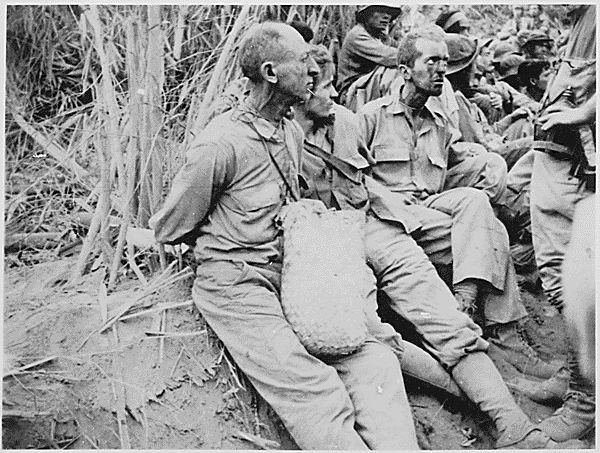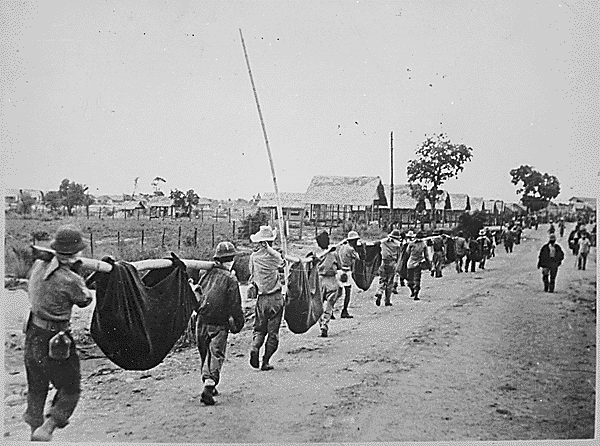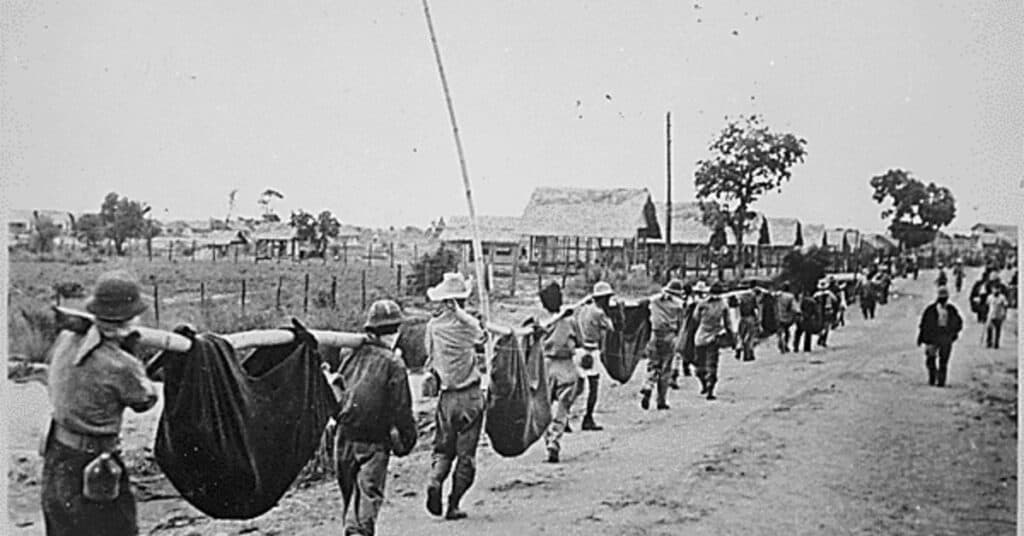Introduction
On a sunny day in April, 1942, about 75,000 Philippine and American troops defending the Bataan peninsula surrendered to the Japanese. They would be spend the next ten days enduring some of the most subhuman treatment the pacific sector of WWII ever saw on a forced march to the nearest prisoner of war camp. Over 10,000 of them would die on the way in what came to be known today as The Bataan Death March.
Let’s get started.
Background
In 1942, Japan was on a rapid roll of conquest across the Pacific following their successful attack on Pearl Harbor in December 1941, which had significantly crippled the U.S. Pacific Fleet. Their expansion included capturing Malaya and Singapore in early 1942, where Singapore, once considered an impregnable fortress, fell in February. They also seized control of the Dutch East Indies (modern-day Indonesia), securing crucial oil resources necessary for their war machine. Burma was another territory taken, and by so doing they pushed the defending British forces out and established a land route to India.
The Philippines, a country comprising of thousands of islands, sits in the Indian Ocean. Its biggest island, Luzon, was the site of the first significant military offensive carried out in the country by the Imperial Japanese army (IJA) against the combined American-Filipino forces in WWII.
The Japanese army steadily pushed back the Americans and Filipinos down south in the island of Luzon. A defensive line was formed from Orión to Bagac to hold off the IJA. General Homma of the… was initially repelled by the line but later on in a three pronged attack, crashed into the line and advanced furiously southward.
General Douglas MacArthur had been hastily evacuated to Australia–the Americans didn’t want to risk his death or capture, as they feared it would be bad for morale. When he left, he famously said: “I shall return.”
Before he returned though, the Japanese had almost the entire peninsula in their grip, and it was obvious that Bataan would fall. With the Japanese navy blockading the entire sector and cutting off supplies, the Bataan defenders had no option but to surrender.
The Bataan Death March
The Japanese had zero concept of what the term “POW” meant. The average soldier in the Imperial Japanese Army was steeped in a relentless wave of propaganda from childhood. Children were indoctrinated with an ideology that glorified sacrifice for the Emperor, painted foreign nations as barbaric threats, and instilled a fervent nationalism that left no room for dissent. This pervasive propaganda shaped their worldview, turning them into willing cogs in a military machine driven by the state’s imperial ambitions.
They were severely psychologically conditioned to believe that they belonged to a divine race, ruled by the emperor who was more or less a god. They were taught fearless and unquestioning obedience to the emperor, and that involved dying for the country. The Japanese felt that surrendering in battle was the most despicable thing to do, so they had nothing but disgust and contempt for POWs. Add that to how much they suffered to capture Bataan and you have men very enraged with their captives.
The Commander of the overall US force in Bataan, Major General Edward King, asked Major General Kameichiro Nagano, commander of the 21st Division’s infantry group that his men be treated as prisoners of war. Nagano told him that the IJA were not barbarians.
The march started on April 9th, 1942, after the surrender of the US-Filipino forces. The Japanese, perhaps due to their inability to fathom surrendering in battle, did not expect such a high number of POWs. They had guessed that they wouldn’t have to deal with more than 30,000 troops, but the men they captured were about 75,000.
The soldiers’ possessions were confiscated. This who had Japanese items or money were shot immediately, as they assumed it had been stolen from dead Japanese soldiers. Stripped of all possessions, they were placed in groups of a hundred men each and sent off from Mariveles on 10th April. Others went out from Bagac on the 11th, converging with the rest of the trail somewhere eastward and continuing north to the San Fernando railroad. This was a distance of about 66 miles (about 106 kilometres).
Japanese Brutality
Some soldiers died before the Bataan death march started, as about 350-400 Filipino soldiers were massacred in the Pantingan river where they surrendered. Some accounts report that although General Homma–the overall superior commander in the region–had instructed that the POWs be transferred safely, Masanobu Tsuji had given an unofficial order to the Japanese to execute all captives on the spot. Tsuji was an important Japanese officer and tactical planner in the Pacific war.
Each group of hundred had four guard soldiers with them. Each group of guard soldiers behaved differently, as some agreed with Tsuji’s orders while others treated them how the Japanese normally treated POWs. There was no food for men who were already starving, and they were forced to march 25 miles every day. If you fell out of line or dropped the pace you were shot. If you asked for rest from the hot sun, you were shot. The Japanese would march them to wells of water and refuse to let them drink. Many POWs lost their minds from thirst, and the sick ones were bayoneted. If you were too weak to continue the march, you were kicked and beaten. If you still couldn’t get up, a bellyful of bayonets would see you off.

Some men who couldn’t endure the thirst, ended up drinking very polluted water, which caused them severe dysentery. There was the tropical heat too, and the mosquitoes, spreading malaria all over the place. Men went derilious with fever, and the Japanese stabbed, shot and beheaded men at will.
In this hellhole of human cruelty, there were rare wisps of kindness. Some local Filipinos at the risk of death, smuggled rice and sugarcane packages to the soldiers walking by. This saved the lives of some of the men, as it gave them energy to continue a few more miles. Few Japanese soldiers were unexpectedly kind, returning some of the possessions that were stripped from the POWs.
The road was littered with the bodies of dead soldiers. The march would stop sometimes to let convoys pass through, and the passing vehicles and tanks would churn up the bodies of the dead and dying into grotesque dismembered bits. Some were buried alive and others were beat to death. The soldiers would hold killing contests and behead POWs for sport. Nobody was let off the trail to urinate or defecate. You did it where you stood, and many people got infected from the stool running down their trousers and into their open wounds.

When they finally got to San Fernando, they were shipped by rail in boxcars to Capas. Each boxcar was supposed to hold about thirty people, but one hundred men were crowded into each boxcar. It was sweltering hot and men passed out, but they couldn’t collapse because they were squeezed together. At Capas it was another 10 miles to Camp O’Donnell, where they were given just a meagre bowl of rice. It would be three more years of suffering before they would be liberated in 1945. An estimated 500-850 Americans and 5,000-18,000 Filipinos died on the march, and many hundreds more died daily in the camp until it was liberated, adding another 20,000 to the death toll.
The Aftermath
It was in January 1944 that the US government released statements of survivors of the Bataan death march, probably to enrage the troops that were battling the Japanese in The Philippines. The Japanese countered the Americans in a propaganda counterattack, stating that the Bataan POWs weee treated kindly, and that the death rate was due to the refusal of some units to surrender until the point of death.
After the war, General Homma was put on trial for war crimes. He claimed ignorant of the atrocities committed by his troops but was found guilty. In 1946 he was sentenced to die and was executed by firing squad. Tsuji however escaped justice, fleeing to China from Thailand. He later served as an administrator in post-war Japan. His two direct subordinates were tried and hanged.
On 13th September 2010, the Japanese foreign minister apologised for the Bataan death march. Memorials were set up all over the United States and the Philippines for those who died during the march, a memorial marathon is conducted at the White Sands Missile Range, New Mexico.
This is the perfect highlight of the cruelty of war and the depths to which that cruelty can descend. We fight wars, but we also fight them against other humans, and the Japanese government failed by dehumanising the people they fought against. The Bataan death march strained relations between the Americans and the Japanese and it is one of the most shameful things about humanity in the Second World War.

